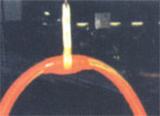Accessories
| HOSE GUARD |  |
These Polyurethane hose suspension saddles provides perfect hose support during fitting and operations for all types and sizes of hoses from 1″ up to8″. |
| SUPPORT |  |
Wide polyester support slings are recommended for fitting or supporting  hoses during operation. hoses during operation.We recommend the use of one support sling every 5 meter of hose. We can supply two different sizes:
|
| ANTI ABRASION COLLARS |  |
These collars have been studied to reduce abrasion damage to the hose when is in direct contact with the floor. Anti-abrasion collars are made in abrasion resistant rubber, fitted onto the outside diameter of the hose, at intervals from 300 to 600 mm, thus preventing floor contact. |
| ROPE LAGGING |  |
External rope lagging can be provided to protect from abrasion as well as acts as natural bending support. The rope also offers good insulation properties, particularly useful in the cryogenic applications. |
Important Instruction for Storage, Handling & Cleaning
CLEANING OF  HOSES
HOSES
- As regards the cleaning, the method that can be used depends upon service, location and type.
- Flushing out is adequate in most situation using a variety of fluids e.g. Clean water, hot water, sea water, detergents and solvents at ambient temperature.
- If seawater used the hose must be well drained after cleaning, to minimize corrosion.
- Case must be taken the maximum temperature of the hose not exceeded.
- Steam lenses should NOT be used.
- Compressed air may be used on open ended polypropylene lined hoses, but is not recommended on PTFE lined hoses.
- Polypropylene hoses can be cleaned with “loose” steam (i.e. at no pressure, 1 Bar = 99°C), taking care not using lances.
- PTFE lined hoses can be cleaned at higher temperature (up to 160°C) taking care that the PTFE lining is much more delicate than Polypropylene, so we do not recommend using air or water or steam at high pressure with this type of hoses to not compromises integrity if linner layer.
- Mechanical methods of cleaning must NOT be use e.g. pigging.
- It is important that the hose is electrically earthed during operations, to avoid build up to static charge.
LENGTH
- A characteristic of composite hose is elongation. This characteristic should not be used solely as an assessment of the condition of the hose or an indication of failure. For application where length in use is critical, this data should be advised to the manufacturer.
- The length of the hose should be the OAL including the end fitting. OAL measurement should be from flange to flange face, seat to seat, end of threads to the threads, etc.
- In the fabricated condition, after testing, the overall length, (OAL), should be within +5% – 2% of the OAL.
STORAGE
After service, hose assemblies should be flushed out and drained, stored hoses should be dry and kept off the ground in a straight line out of direct sunlight.
INSTALLATION & USAGE
- Hose must be correctly supported during use. A characteristic of composite hose is flexibility, therefore the supports should be arranged so that the hoses are never bent beyond the minimum bend radius, Support have to be appropriate, never use a single rope, chain or wire, but use slings, saddles and wide enough to spread the load sufficiently so that the hose is not deformed in the area of support.
- Flanged hose assembles should ideally have one end secured with a floating flange.
- Hose assemblies must not be twisted either on installation or in use.
- Hose assemblies subject to movement while operating should be installed in such a way that flexing occurs in the same plane.
- When installing hose assemblies, careful attention should be paid to minimum bend radii specification.
REPAIRS
- Depending on the overall condition of the hoses assembly, it is possible to repair hoses which have been damaged during service. Repair Composite hose requires specialist knowledge, therefore please ask to consult our Technical Department.





